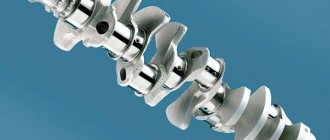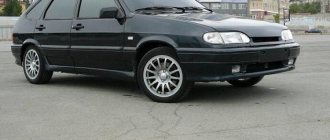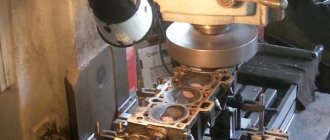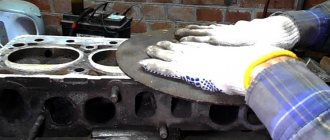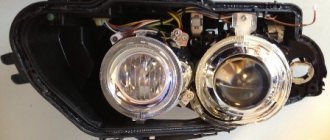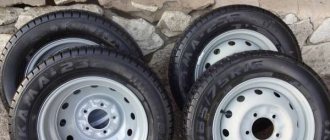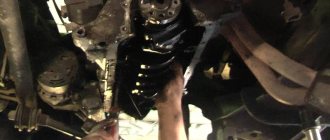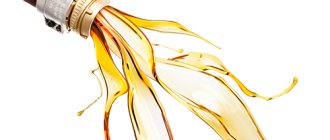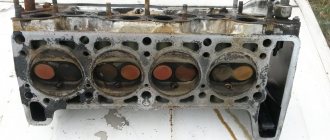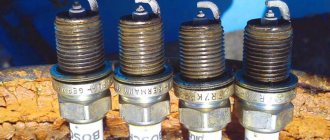The design of an internal combustion engine is a complex mechanism. All parts and components are extremely important and perform their function while the engine is running. With a certain mileage, metal components require restoration to factory condition. This, in fact, is called “engine overhaul.” One of the most expensive engine components is the crankshaft. First of all, it is subject to intense wear. Let's figure out what crankshaft grinding is and when it is needed.
general information
The crankshaft is the main mechanism of the crank group of an internal combustion engine. Designed to convert translational motion into rotational motion. This is realized using complex part geometry. During operation of the internal combustion engine, the entire crank mechanism (hereinafter referred to as the crankshaft mechanism) experiences significant loads. These are inertial loads and gas pressure as a result of combustion of the fuel-air mixture in the cylinders. In total, the loads are not constant, but variable.
In this regard, special requirements are put forward for the manufacture of the crankshaft. It must be resistant to temperature and wear. But any part that is under load for a long time may require repair. In this case, it is boring and grinding crankshafts. Let's take a closer look at what this procedure is and how it is performed.
Our advantages
Result guarantee
Low prices
Tremendous experience
Operation speed
POLISHING CRANKSHAFT JOINTS
for work₽50,000
- for domestic
POLISHING CRANKSHAFT JOINTS
for work₽20,000
- for imported
CRANKSHAFT STRAIGHTENING DEFLECTION UP TO 0.4mm/more than 0.4mm (without guarantee)
for work₽66000
- for imported
- for imported
CRANKSHAFT STRAIGHTENING DEFLECTION UP TO 0.4mm/more than 0.4mm (without guarantee)
for work₽110000
- for imported
- non-parallel planes
RESTORATION OF OIL KRULLING
for work₽75,000
- for domestic
MACHINING FOR THRUST RINGS
for work₽50,000
- for domestic
GRINDING THE SURFACE UNDER THE SEAL
for work₽25,000
- for domestic
REPLACING PLUGS AND CLEANING THE SHAFT
for work contractual ORDER
REPLACING THE BEARING
for work contractual ORDER
Briefly about crankshaft boring
A malfunction of this unit can be identified primarily by the characteristic knocking sound of the internal combustion engine. During operation, inevitable wear of the cylinder-piston group (CPG), as well as the crankshaft, occurs. This leads to backlash and gaps. As a result, the crankshaft begins to knock. To eliminate gaps, repair inserts are installed, which are 0.1-0.2 mm thicker than the factory ones. But to install them, you first need to grind the crankshaft. Using this procedure, the outer diameter of the knee neck is adjusted to the dimensions of the repair liner.
For most cars, 4 sizes of repair inserts are available. This means that the crankshaft can be machined a maximum of 4 times, after which the internal combustion engine or the crankshaft are replaced with new ones. Boring is carried out by a qualified specialist using special equipment in several stages. You can do such work yourself only when you have the necessary experience and tools.
Crankshaft grinding: price and important points
The process is quite complex and requires a lot of experience from a specialist. It is extremely important to follow the technology and understand the operating principle of the crankshaft. The cost of grinding and turning is usually high. But this is a completely justified expense, since a new crankshaft will still cost 40-60% more. Many car owners naively believe that all they need for grinding is an appropriate machine, but this is not at all true. If a master without experience or sufficient interest takes on such work, this can lead to gross mistakes that will result in problems almost immediately.
I would like to dwell in more detail on the question of how much high-quality crankshaft grinding costs. The price varies greatly depending on the make of the car and the installed engine. The more cylinders, the more you have to pay. The domestic VAZ is the cheapest to repair, but V8 engines are extremely expensive. Prices for grinding alone can vary from 2,000 rubles to 15,000, and in some cases even higher.
Crankshaft repair in prices
CRANKSHAFT GRINDING (3-4 cylinders)
for work₽240,000
- for domestic
CRANKSHAFT GRINDING (3-4 cylinders)
for work₽300,000
- for imported
CRANKSHAFT GRINDING (5-6 cylinders)
for work₽380,000
- for imported
CRANKSHAFT GRINDING (8 cylinders)
for work₽420,000
- for imported
ORDER
Grinding of connecting rod (or main) journals only from the price.
Grinding of crankshafts with narrow (less than 20 mm) journals, grinding with fillets +50% to the cost of the work.
Grinding technology
As noted earlier, the process is quite complex and responsible. You need to start sanding from the weakest point. In most cases these are main or connecting rod journals. This is especially true for small-diameter necks that do not have a full counterweight. They wear out first. If restoration has already taken place before, then you need to start from substandard points. For example, from the crankshaft shank. This is due to the fact that you can lose the parallelism of the necks and everything will need to be redone.
Some companies are collecting information about engines whose crankshaft grinding did not give the desired result and the internal combustion engine quickly failed. Most often, the cause is a crack that starts from the fillet at the processing site and moves into the area untouched by grinding. The reason is poor quality work of a specialist. Particular attention should be paid to modern forced engines.
Geometry check before crankshaft repair service
Before sending the crankshaft for grinding, you need to check the geometry of the shaft and, based on the test results, select the appropriate repair technology.
Before starting the test, the shaft is installed with its outer main journals on the prisms and the runout of the middle journals is measured using an indicator stand. Then check the runout of the surfaces of the oil seals and the shank, and measure the diameters of the main and connecting rod journals with maximum care. Particular attention is paid to the wear of the middle and outer main journals, and to the ellipticity of the connecting rod journals. Ellipticity is measured in several planes to obtain more accurate measurements.
Based on the results obtained, a repair method is chosen. If the value of the runout of the middle journals of the shaft relative to the outer ones does not exceed 0.1 mm, then the shaft can be polished. If this indicator is exceeded, the shaft must be adjusted.
Before you begin the repair, you need to check several important points.
If the shaft has been ground previously, you need to check the alignment of the shank and the oil seal surfaces of the main journals and check the availability of liners of the required repair size. Such clarification is especially necessary when repairing engine shafts of many foreign cars, since there are often situations when liners of the required repair size are not available for sale, they exist only in catalogs.
If the shaft has journals that are very overheated after the bearings are destroyed, it should be checked with a magnetic flaw detector for the absence of cracks. Cracks that go deep into the body of the shaft or are clearly visible to the naked eye are grounds for its rejection.
The crankshaft is also discarded when the wear of the journals exceeds the maximum repair size. As a last resort, you can try to restore worn shaft journals using welding or surfacing methods.
The preparation for repairing the crankshaft is completed by removing the plugs and flushing the internal channels. This procedure is mandatory, since a large amount of dirt accumulates in the internal channels, which can ruin the best quality repair of the crankshaft.
Grinding crankshaft journals
First of all, a crankshaft grinding machine is used. The part is installed in it. It is necessary that the crankshaft axis passes through one crankpin. The knee must be balanced before any grinding work can be done. If this is not done, the part will soon become deformed and will no longer be repairable.
Reconciliation is one of the most difficult, but at the same time important moments during work. If weights are not placed and alignment is not achieved, the quality of the repair will be insufficient and vice versa. In all cases, wheels for grinding crankshafts should be smaller in size than the journal. Also a prerequisite is the supply of cutting fluid and the insertion depth, which is adjustable in the range from 0.02 to 0.03 mm. The specialist carrying out the work must take all these details into account. There are a huge number of nuances, which is why crankshaft grinding should be carried out in the appropriate place with modern and working equipment.
detailed instructions
We have dealt with the causes and symptoms of the need for recovery. Where to bore the crankshaft and how much does it cost? This is exactly the question that comes to the mind of every vehicle owner who is faced with the need to repair a unit. The answer is simple - the crank pulley can be bored at home, of course, if you have the necessary equipment (machine), tools and certain knowledge.
It is almost impossible to carry out such a procedure in a garage, since this requires a special machine.
But you must understand this topic as much as possible, since studying technical literature and looking once, as a specialist does, will be extremely insufficient. At a minimum, you need to have relevant experience. So, how boring occurs - the entire technological process with a detailed description is provided below.
Loading …
Tools, machine
- The first thing you need to restore a unit is a specialized machine. Please note that without it, work will be impossible; the machine is the most important thing.
- Set of wrenches.
Boring machine
1. Set of keys
Stages
- So, let's move on to the technological process. First of all, it will be necessary to remove all attachments from the engine. In this case, you also need to remove the clutch from the flywheel, as well as the gearbox. Drain all consumables (motor fluid, antifreeze) from the systems. Wait a while until all the oil is completely drained. Use all the tools necessary for this.
- After all attachments have been removed, the engine should be removed from the engine compartment. Of course, you are unlikely to be able to cope with this task yourself, so make sure you have an assistant in advance.
- Next, you need to open the engine sump. After this, you can unscrew the caps of the connecting rod and main bearings. Use all the necessary tools for this. When the covers are unscrewed, they can be dismantled along with the liners, and the crank pulley itself should be removed for restoration.
- The next step in the crankshaft restoration process is a complete cleaning. This is done before boring it. Cleaning the element should be the most efficient as this step is very important in the entire process.
- As a rule, the grinding process itself begins with working with the connecting rod journals. To carry out this procedure, the crankshaft must be installed on a specialized machine. As you can see in the photo, you are unlikely to be able to rent such a machine, so this procedure is only possible in specialized car services or in production. The connecting rod journals must be properly ground, following the technology (the most worn journal is measured first to determine the dimensions to which boring must be carried out). If you get this wrong, the consequences may be irreversible, even to the point where the component will need to be replaced.
- Once this step is completed, the machine needs to be balanced. After balancing using stands with an indicator, the elements must be in such a form that the axis of the journals does not coincide; they should be aligned along the axis of rotation. This condition is mandatory, so please pay attention to this as well. Thus, when balancing, the outer surface of the journals is ground down to the required dimensions.
- And only then, when all the above steps have been completed and the unit is installed on the machine, you can begin the process of grinding the crank pulley itself. You need to sand it properly, after which the crankshaft is washed. Flushing must be carried out very efficiently, special attention must be paid to the lubrication channels.
- After all these stages comes the turn of the molar necks. As in the previous case, you need to start with the neck that is worn out the most. This way their repair size is determined. All other necks are adjusted to these dimensions.
- Then, when all steps of the process are completed, you should check the correct shape of the node. There is no point in comparing with standards, otherwise what is the point of polishing. But all sizes must match each other and be proportional. Some carry out boring of the crankshaft with spraying; this step allows you to increase the service life of the unit. However, spraying is not a prerequisite, so we will do without it.
Dismantled engine
Crankshaft on a machine
Spraying procedure
Engine crankshaft after grinding
When all work is completed, it is necessary to completely clean the assembly from wear products, that is, metal shavings and other debris. Next, the assembly must be lubricated, then all components of the mechanism are assembled. The resulting assembly is mounted back into the engine. The entire assembly occurs in reverse order.
Let's sum it up
We have already figured out a little about how crankshaft grinding is carried out. Reviews about these works are not always unambiguous. Some people, thanks to the highly qualified craftsman, are extremely satisfied with the quality and timing of the work. But not all specialists treat their work conscientiously, and it is difficult for a simple motorist to visually understand whether all stages were completed correctly and whether the desired result was achieved. In any case, it is necessary to take a responsible approach to choosing a service where repairs will be carried out. Today there are a huge number of thematic forums where owners of a certain brand of car gather. There you can find out where and how well certain types of work are performed at a particular service station.

